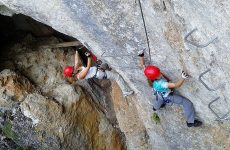
This article is meant to be a brief introductions for a beginner to the art of rock climbing. Rock climbing has its jargon and unusual terminology. However, since this is a beginner’s guide, we will try to avoid using strange terms so that you can easily understand the content.
Getting Started With Rock Climbing
You may have been captured by the tantalizing footage in a movie or TV show, or even come across a breath-taking picture of a serious climber. However, when you look around your neighborhood, you can’t seem to find an expert and you don’t know how to get started.
Technical climbing is an exciting adventure, although it is not for everyone. For experienced mountain climbers and hikers, rock climbing is the logical next step. Expert rock climbers all started somewhere, but it can be difficult to determine how they started if you are not familiar with them.
Therefore, the first step you need to take, as a beginner, is to look for people or a person that has the same interest as you. If you are interested in climbing at an indoor gym, there is a chance that there is someone around that can teach you the rudiments. You only need a lesson or two to get started on the right foot.
Moreover, if there are natural cliffs in your area, you may be more inclined towards outdoor climbing. And if you have a outdoor climbing gear store in the area, you can ask people at the store for their advice. Ask them if there are local instructors and whether they know of a climbing club in the area or if there is a network of climbers already.
Another important thing is to use just any stranger for your training. If you can go through the webpages of the AMGA (American Mountain Guides Association), you should be able to see an extensive listing of guides and accredited programs.
When you are starting out, some of the things you may need include climbing shoes, a harness, some chalk and a chalkbag, a helmet, a belay device and a carabiner. There is a ton of other pieces of gear, but these are the basic necessities.
Tips for Successful Climbing
As a beginner, there is no need to go on-sighting (trying a new climbing route without rehearsal). You can focus on other more important factors than on where to do your activity. If you have a route you have climbed before, try it. Otherwise, look out for those routes that others at your level are using. If you still can’t do that, you can read a guidebook or learn how to read a route from the ground up. Learning the techniques, the ratings, the gear needed, and where the crux is can be a rewarding activity.
The worst thing that can happen to a climber is getting halfway through a route and running out of gear. If you are going for a traditional lead, it is a good idea to find out what gear will be needed. Alternatively, study what rack others have for the route. Another important thing is to see to it that you know where most of the clips will be placed, whether right or left.
Before you leave the ground, understand back-clipping (incorrectly clipping the climbing rope into the bottom carabiner). Back-clipping is a real threat to climbers and it is important that you learn about it before you take off. It is possible for a climber to slip out of the gate when a carabiner gate gets bent.
Even if you think you have planed everything out, how sure are you about the capability of your belay device? Can the belay help you get back on track when your leg starts to tremble at the middle of a route? Think about these things before you set off and you will thank yourself.
Instead, focus on climbing. Falling is always a threat. Most people fear and have kept them well afar from anything that involves climbing. If your belayer is okay and the route is well protected, there is nothing to fear because your fall should be safe. However, if you are not convinced, then let the fear be washed away by taking a deep breath and telling your belayer you are falling. Falling like a pro might be tricky sometimes, but if you don’t trust your belayer enough, why go beyond it? Besides, falling like a pro will always take a lot of practice so make sure you have enough of that.
Will you be able to finish the route? If you can’t, what will you do? Do you have a partner that can help you complete the route? These are important questions to ask before starting.
Your First Climb
An ideal crack for beginner is a two-pitch 5.7 hand crack on a wall. This can have a gentle slope and an easy rating. Make sure there is enough rack and the route is familiar before you jump in.
There are some months in the year that climbing can be more rewarding. You can study those periods when the weather is most stable and when your view will be clearer. In addition, if climb somewhere where there are other climbers around, it might become a much more relaxing activity for you.
It is common to see beginner climbers getting agitated and worrying unnecessarily. Although this is a natural feeling, you have to quickly dispel it before it destroys your day.
As some people will say: Just Do It.
After you are back on the ground, try to go out and reward yourself. You have done what most people only dream of. You are better than before since you are able to conquer your fears.
Conclusion
Learning how to rock climb can be a rewarding activity. Some people might say it’s a nice past time. Rock climbing is an activity that has been considered the preserve of the elite, even though it’s not. You get to learn about exciting things and challenge yourself. Your first climb will leave you tired and fulfilled. If you are still getting a hang of it, persevere—rewarding experiences await you.


